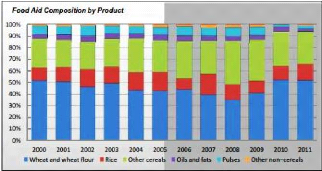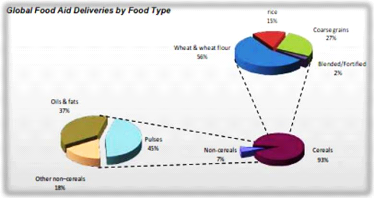B- Composition of Food Aid
From its inception the majority of food aid has consisted of
cereal grains; wheat is the most typical commodity followed by maize, rice and
other commodities. During the late 1970s at least 500,000 MT or 5% of global
food aid was distributed in the form of non-cereal commodities. Data for the
beginning of the 21st century show non-cereal food aid as representing about
1.5 million MT or between 10 and 15% of total global food aid shipments by
weight at. FAOSTAT data on non-cereal food aid are not available before 1977
and from 1977 to 1986; data for non-cereal food aid are incomplete as they
include only quantities of food aid in four non-cereal commodities: skimmed
milk powder, vegetable oil, butter oil and other dairy products. The apparent
increase in non-cereal food aid from 1977 to present levels is therefore likely
the result of both more complete data and an actual increase in volumes of
non-cereal food aid. Pulses and vegetable oils are the most common non-cereal
commodity by weight. Included in non-cereal deliveries are dry milk products
which have recently been contested due to their large volume relative to
production.
The composition of food aid donations has changed
significantly over the years: the shares of cereals, non-cereals and pulses
have increased along with more donations of micronutrients and iodized salt.

Figure 1: Food Aid composition by product from 2001 to
2011. Source: WFP
25
International humanitarian food aid in the North-South
cooperation: the case of Cameroon 2014
Cereals accounted for 93 per cent of deliveries, and
non-cereals for the remaining 7 per cent. Compared with 2010, the share of
cereals decreased by 1 per cent; non-cereals increased by the same
percentage.

Figure 2: Global Food Aid Deliveries by Food
Type in 2011. Source: WFP
The share of cereals increased by 4 per cent in Sub-Saharan
Africa and by 5 per cent in the Middle East; there were decreases of 8 per cent
in Asia, 1 per cent in Latin America and the Caribbean, and a negligible
decrease in Eastern Europe and the CIS. The five countries receiving the most
cereals were: Ethiopia (19 per cent), Pakistan (10 per cent), Kenya (7 per
cent), the Sudan (5 per cent) and Mozambique (4 per cent).
Deliveries of blended and fortified foods - corn-soya blend,
Faffa (a formula for infants, commercially produced in Ethiopia) and Nutrimix -
amounted to 92,000 mt. The products Plumpy'nut - a peanut-based paste for the
treatment of severe/acute malnutrition - and Nutri- Butter - a nutritional
supplement in the form of ready-to-use paste - more than doubled their share of
the «other non-cereal» category.
26
International humanitarian food aid in the North-South
cooperation: the case of Cameroon 2014
|
Food type
|
2010
|
2011
|
|
Mt (000)
|
%
|
Mt (000)
|
%
|
|
Cereals
|
|
5 539
|
94
|
3 798
|
93
|
|
Wheat and wheat flour
|
3 254
|
55
|
2 117
|
52
|
|
Rice
|
682
|
12
|
566
|
14
|
|
Coarse grains
|
1 409
|
24
|
1 024
|
25
|
|
Blended/Fortified
|
194
|
3
|
92
|
2
|
|
|
|
|
|
|
|
Non-
cereals
|
|
338
|
6
|
270
|
7
|
|
Dairy products
|
4
|
0
|
5
|
0
|
|
Meat and fish
|
2
|
0
|
8
|
0
|
|
Oils and fats
|
151
|
3
|
101
|
2
|
|
Pulses
|
145
|
2
|
121
|
3
|
|
Other non-cereals
|
35
|
1
|
34
|
1
|
Table 1: Global Food Aid Deliveries by Food Type in
2010-2011. Source: WFP
Table 1 shows that food aid deliveries of all categories
except meat, fish and dairy products declined from 2010 levels: i) rice fell by
17 per cent, but its share of cereals increased by 2 per cent; ii) coarse
grains fell by 27 per cent, but their share of cereals rose by 1 per cent; and
iii) pulses fell by 17 per cent, but their share of non-cereals rose by 1 per
cent.
| 

